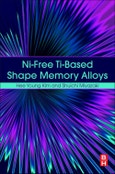Ni-free Ti-based Shape Memory Alloys reviews the fundamental issues of biomedical beta-type Ti base shape memory and superelastic alloys, including martensitic transformation, shape memory and superelastic properties, alloy development, thermomechanical treatment and microstructure control, and biocompatibility. Some unique properties, such as large nonlinear elastic behavior and low Young's modulus, observed in metastable Ti alloys are discussed on the basis of phase stability. As it is expected that superelastic Ti alloys will further expand the applications of shape memory alloys within the biomedical field, this book provides a comprehensive review of these new findings in Ti-base shape memory and superelastic alloys.
Please Note: This is an On Demand product, delivery may take up to 11 working days after payment has been received.
Table of Contents
1. Martensitic transformation characteristics 2. Shape memory effect and superelasticity 3. Effect of alloying elements and alloy development 4. Thermomechanical treatment and microstructure control 5. Unique properties of meta-stable beta Ti alloys 6. Biocompatibility of superelastic beta Ti alloys 7. Fabrication and characterization of shape memory alloys
Authors
Hee Young Kim University of Tsukuba, Tsukuba, Japan. Prof. Hee Young Kim received his Ph. D. in Materials Science and Engineering from Korea Advanced Institute of Science and Technology (KAIST) in 1998. From 1999 to 2001 he was a research associate in the Graduate School of Engineering at Kyoto University. In 2001,he became an assistant professor at Tohoku University. During 1999-2001, he worked on the high temperature deformation behavior of intermetallic compounds. He joined the Institute of Materials Science at University of Tsukuba in 2002 as an assistant professor, and was promoted to associate professor in 2007 and professor in 2014. Since joining the University of Tsukuba, he has expanded his research program into functional metallic materials, with an emphasis on the development of novel shape memory alloys for biomedical applications, high temperature applications, and micro-actuators. Prof. Kim has authored or co-authored more than 150 research publications including 25 papers published in Acta Materialia. He received a Young Researcher Award in 2002, Murakami Young Researcher Award in 2009, and Meritorious Award in 2013 from the Japan Institute of Metals. He was honored as the best faculty member in the University of Tsukuba in 2014. Shuichi Miyazaki Professor, Division of Materials Science, University of Tsukuba, Japan.Prof. Shuichi Miyazaki obtained a Ph. D. degree in Materials Science and Engineering from Osaka University in 1979. After receiving his Ph. D., he immediately joined the University of Tsukuba where he is currently a Professor in the Division of Materials Science. Prof. Miyazaki has co-edited and co-authored 7 books, including "Shape Memory Alloys, "Shape Memory Alloys for Biomedical Applications, "Thin Film Shape Memory Alloys, and "Shape Memory and Superelastic Alloys. He has also co-authored 26 book chapters and co-edited 12 special issues in International Journals. He has also co-authored 434 technical papers and 71 review papers published in Materials Science and Engineering, especially relating to shape memory alloys including TiNi alloys, Cu-Al-Ni alloy, Ni-free Ti-base alloys, etc.
Prof. Miyazaki has been the recipient of sixteen awards, including the Yamazaki-Teiichi Prize from the Foundation for promotion of Material Science and Technology of Japan in 2002, the Minister Award from the Ministry of Education, Culture, Sports, Science and Technology, Japan in 2004, the ISI Highly Cited Researcher in Materials Science Field from Thomson Reuters in 2004, the First place in Class 5 at the International Metallographic Contest from the International Metallographic Society/ ASM International in 2006, the Gold Medal Award from the Japan Institute of Metals in 2014, the Tsukuba Prize from The Science and Technology Promotion Foundation of Ibaraki in 2014, and the Honda Memorial Prize from the Honda Memorial Foundation in 2015.
Prof. Miyazaki has held several different roles including serving as the President of the Japan Institute of Metals, a Cooperation Member of the Science Council of Japan, a Member of International Advisory Committee of the International Conference Organization on Martensitic Transformations, a Board Member of the International Organization of Shape Memory and Superelastic Technologies in ASM International, and a Board Member of the Honda Memorial Foundation.








